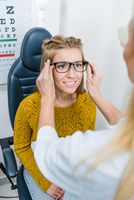
We measure a person’s visual acuity using a ratio of two numbers, like 20/20. But few people understand what these numbers stand for and how they relate to a person’s sight. The following guide can help you determine what to expect during an eye exam and how to evaluate your results.
How Is Visual Acuity Measured?
Most physicians use a Snellen or LogMAR chart to measure a person’s visual acuity. These charts feature a series of letters positioned in rows across the page. As the rows descend, the font gets smaller, and the letters are harder to decipher.
During a visual acuity test, a patient stands 20 feet away from one of these charts and reads aloud as many rows as possible. The physician will record the smallest row the patient can read. If the patient can stand 20 feet away from the chart and read the same row as the average person, it means they have 20/20 vision.
If they have vision that’s slightly below average, they could have 20/32 vision, which means they can see at a distance of 20 feet what the average person could see at a distance of 32 feet.
The numerator is always the same in this ratio because it stands for the distance between the viewer and the eye chart. The denominator changes depending on the person’s visual acuity. If the denominator is higher than 20, their vision is below average; if it’s lower than 20, their vision is above average.
 What Does It Mean to Be Nearsighted?
What Does It Mean to Be Nearsighted?
Nearsightedness, also called myopia, can affect a person’s visual acuity. With this condition, light doesn’t enter the eye at the correct angle because the eyeball shape is slightly oblong or the cornea is too curved. As a result, people with nearsightedness have trouble seeing objects that are far away but have sharp vision when it comes to viewing objects up close.
What Does It Mean to Be Farsighted?
Farsightedness, or hyperopia, is the opposite problem: the eyeball could be shorter than normal, or the cornea is too flat. If someone is farsighted, they probably have trouble seeing objects up close but can see objects farther away. They might have trouble reading a book, for example, but can see road signs easily while driving.
How Are Refractive Errors Treated?
Nearsightedness and farsightedness are both refractive errors that can be diagnosed by conducting visual acuity tests at various distances. A physician can also spot anatomical variations during an eye exam.
If you have a visual acuity problem, the doctor will likely treat the condition using prescription eyeglasses, contact lenses, or laser surgery.
If you need an eye exam to properly diagnose and treat a visual impairment, Kenneth Houchin, MD can help. Dr. Houchin works in Las Vegas, NV, to help people achieve 20/20 vision through corrective lenses or laser surgery. He also treats a range of other eye conditions, including those with neurologic causes, like multiple sclerosis or stroke. Call (702) 718-2020 to schedule an eye exam today.
About the Business
Have a question? Ask the experts!
Send your question

